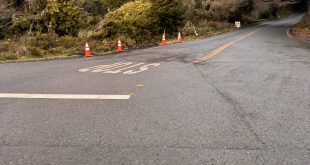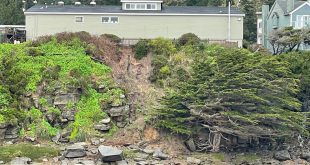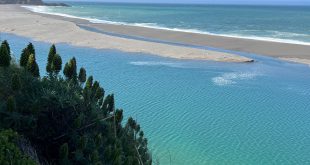Letter regarding CDP #55-2006
by Julie Verran
Ms. Beddoe, Mr. Lynch, Mr. Hall,
CDP #55-2006 should be denied. The only viable alternatives are No Project, or public use as a park with a bluff trail, parking and more native trees and shrubs planted to help shield Highway 1 and the rest of downtown Gualala from tsunami run-up. That would be a coastal dependent use that would enhance the visual esthetics of Gualala, while the above proposal for a large seawall as a prelude to a new commercial shopping center and parking is not a coastal dependent use and would detract from Gualala’s viability as a place to live and visit. No consideration is given in the staff report to the probability that the entire site of Mr. Bower’s proposed new commercial development lies in a tsunami run-up zone.
Mr. Bower owns a 40-acre parcel located above the tsunami run-up area that is zoned for Planned Development. He is currently logging that parcel, which may be more suitable for commecial use that would enhance the community than is the site of CDP #55-2006. Please look at the Coastal Commission website for the agenda of the September, 2005 Tsunami Workshop with links to slide presentations by Senior Engineer Lesley Ewing, HSU Prof. Lori Dengler, and Staff Geologist Mark Johnsson. TsunamiWorkshopAgenda.pdf These presentations are noted as for education only. I attended and took notes at the 2005 workshop, which was very educational.
Dr. Johnsson wrote under Land Use Recommendations, “Consider tsunamis when making land use planning decisions in potential tsunami innundaton zones. These recommendations should be applied in coordination with existing requirements for flood zone mapping, wave run-up for storm events, design standards for flood and seismic loadings and special design requirements for select facilities; the most restrictive and conservative condition should be used for final planning and design purposes.” [slide #8 of 23]. Without a 100-year flood map, a wave run-up map and tsunami run-up maps, CDP #55-2006 is dangerously incomplete. Mendocino County should apply the above standards, or newer, more restrictive ones, to any development situated, as this one is proposed, at less than 60 feet above mean high tide.
I visited the Coastal Planning office in Fort Bragg twice in September to look at the file on CDP #55-2006, and spoke with Ms. Beddoe about incomplete botanical and biological reports. She relayed on my second visit that she had spoken with the consultant, who dismissed my concerns. The botanical report is incomplete because the property was surveyed during one bloom period, not the three required by the Department of Fish and Game. I earned a certificate in Protocols for Botanical Surveys earlier this year. It is the beginning step to a licensing program for botanists in California.
I own property located about one-quarter mile from the project site, where Calystegia purpurata ssp. saxicola, coastal bluff morning glory, was confirmed in 2004 by Dr. Richard Brummitt of Kew, who is the leading authority on the genus, and who collected a range of specimens on my property. [personal communication from T. Sholars]. I believe the Calystegia sp. occurring on the seawall site in CDP #55-2006 is C. p. subsp. s., listed as a rare California endemic plant, and that it is part of the same occurrance of the plant as is present at my place.
The biological report for CDP #55-2006 is incomplete in listing few animals and birds using the mature coastal bluff scrub ecosystem dominated by Garrya elliptica that occurs on the bluff proposed for the seawall. Among other creatures, the river bank there is used by interesting river otters, Lontra canadensis, who predate on seabirds that congregate on the estuary and its sandbars and banks. Residents and visitors are delighted to observe the busy otters from the Gualala Bluff Trail, which is part of the California Coastal Trail and would be partially destroyed to build the proposed wall. My family and I have been observing generations of these otters since 1969. We cherish them, as does the community.
We also cherish our trails, many of which we have lost in recent years to coastal development which was not coastal dependent. So much extraordinary volunteer work went into the trail that its destruction for a seawall could be a blow from which the community might never recover socially or economically. People are using the trail in far greater numbers than they were before Reddwood Coast Land Conservancy built the embellished trail across the CDP #55-2006 parking lot. It is a true promenade now.
Please deny CDP #55-2006 and encourage the owner to donate or sell the property for a public park that would help screen the rest of the downtown from storm waves and tsunamis. The value of shoreline vegetation is something the world learned from the great tsunami in Southeast Asia at the end of 2004.
Sincerely,
Julie A. Verran
Gualala, CA
More information on the proposed development CDP #55-2006.
 Friends of Gualala River Protecting the Gualala River watershed and the species living within it
Friends of Gualala River Protecting the Gualala River watershed and the species living within it


